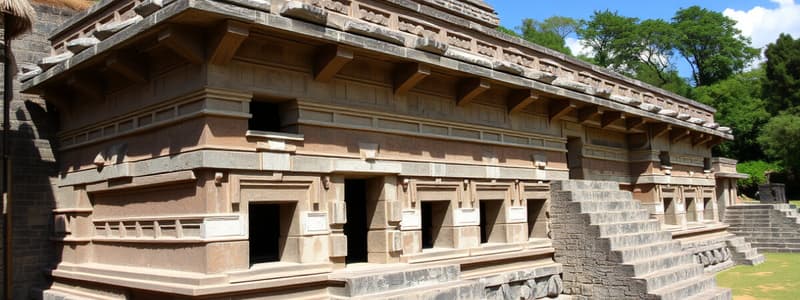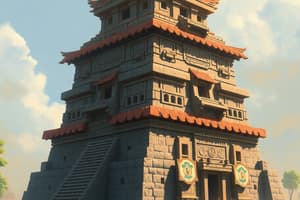Podcast
Questions and Answers
What material was primarily used for Maya construction?
What material was primarily used for Maya construction?
- Limestone (correct)
- Concrete
- Marble
- Sandstone
Which site is famous for the Pyramid of Kukulkan?
Which site is famous for the Pyramid of Kukulkan?
- Palenque
- Tikal
- Chichen Itza (correct)
- Uxmal
What is a significant feature of Inca agricultural practices?
What is a significant feature of Inca agricultural practices?
- Irrigation using animal power
- Terracing on mountainous terrain (correct)
- Hydroponic farming techniques
- Urban rooftop gardens
What type of masonry is characteristic of Inca construction?
What type of masonry is characteristic of Inca construction?
Which Aztec god is associated with war and the sun?
Which Aztec god is associated with war and the sun?
What was a common feature of Aztec religious temples?
What was a common feature of Aztec religious temples?
What defines the Olmec culture's contributions to Mesoamerican civilizations?
What defines the Olmec culture's contributions to Mesoamerican civilizations?
What technique was commonly used in Moche pottery to create intricate designs?
What technique was commonly used in Moche pottery to create intricate designs?
Which of the following was NOT a role of Moche pottery?
Which of the following was NOT a role of Moche pottery?
Which aspect of Inca engineering is most notable for connecting their vast empire?
Which aspect of Inca engineering is most notable for connecting their vast empire?
Flashcards are hidden until you start studying
Study Notes
Maya Architecture
-
Characteristics:
- Known for pyramids, temples, and palaces.
- Use of limestone for construction.
- Distinctive stepped pyramids, often with flat tops.
-
Key Sites:
- Tikal: Major city with large pyramids and plazas.
- Chichen Itza: Pyramid of Kukulkan, astronomical alignments.
-
Design Elements:
- Intricate carvings and reliefs.
- Use of corbel arch in structures.
- Integration of nature and landscape in planning.
Inca Engineering
-
Innovations:
- Advanced road systems connecting vast territories.
- Suspension bridges made from natural fibers.
- Terracing for agriculture on mountainous terrain.
-
Building Techniques:
- Ashlar masonry: Stones cut to fit together without mortar.
- Construction of fortresses like Sacsayhuamán with massive stones.
-
Water Management:
- Complex aqueducts and irrigation systems to support agriculture.
Aztec Religion
-
Polytheism:
- Worship of multiple gods, including Huitzilopochtli (war and sun) and Quetzalcoatl (civilization and wind).
-
Rituals:
- Human sacrifices to appease gods, believed essential for the sun's rise.
- Ceremonial calendars guiding festivals and rituals.
-
Temples:
- Great Pyramid of Tenochtitlan: Major religious center.
- Ritualistic centers often built on elevated sites.
Olmec Culture
-
Period:
- Considered the "Mother Culture" of Mesoamerica, flourishing from 1200-400 BCE.
-
Art and Architecture:
- Colossal head sculptures carved from basalt.
- Development of the first pyramids in Mesoamerica.
-
Society and Influence:
- Engaged in trade with neighboring cultures.
- Influenced later Mesoamerican civilizations in art, religion, and governance.
Moche Pottery
-
Style:
- High-quality ceramics, often depicting human and animal forms.
- Use of intricate mold-making techniques for detailed imagery.
-
Functionality:
- Pottery used for both practical purposes and ritualistic practices.
- Ceremonial vessels often featured elaborate designs.
-
Iconography:
- Depictions of warriors, mythological creatures, and deities.
- Reflects social hierarchy and religious beliefs of the Moche civilization.
Maya Architecture
- Distinct architecture includes pyramids, temples, and palaces prominently featuring limestone.
- Stepped pyramids are a hallmark design, often equipped with flat tops for ritual use.
- Tikal serves as a major urban center with large plazas and pyramids, showcasing Maya civilization's grandeur.
- Chichen Itza is renowned for the Pyramid of Kukulkan, noted for its astronomical alignments.
- Structures are characterized by intricate carvings and the innovative use of corbel arches.
- Planning integrates natural landscapes, enhancing aesthetic and spiritual connections.
Inca Engineering
- Innovations include an extensive road system facilitating connectivity across the Inca Empire's vast territories.
- Suspension bridges constructed from natural fibers demonstrate advanced engineering skills.
- Terracing techniques adapted agriculture to mountainous terrains, optimizing land use.
- Ashlar masonry is a signature building technique, where stones fit together tightly without the use of mortar.
- Notable fortresses like Sacsayhuamán are built with massive stones, exemplifying Inca military architecture.
- A complex network of aqueducts and irrigation systems supports agriculture and resource distribution.
Aztec Religion
- Polytheism is central, with deities such as Huitzilopochtli, overseeing war and the sun, and Quetzalcoatl, a god of civilization and wind.
- Human sacrifices form a core ritual, believed vital for ensuring the sun's daily rise and the gods' favor.
- A ceremonial calendar dictates numerous festivals and rituals, reinforcing community and religious practices.
- The Great Pyramid of Tenochtitlan stands as a key religious center, vital for worship and civic activities.
- Ritual sites are typically situated on elevated terrains, enhancing their spiritual significance.
Olmec Culture
- Flourishing from 1200-400 BCE, the Olmec civilization is often referred to as the "Mother Culture" of Mesoamerica.
- Artistic achievements include colossal head sculptures carved from basalt, showcasing their craftsmanship.
- The Olmecs are credited with the early development of pyramids, influencing subsequent architectural styles.
- Their society was engaged in extensive trade networks with adjacent cultures, fostering exchange.
- Olmec culture significantly impacted later civilizations in various spheres, including art, religion, and governance.
Moche Pottery
- Renowned for high-quality ceramics depicting intricate human and animal figures, showcasing skilled craftsmanship.
- Innovative mold-making techniques allowed for the creation of detailed imagery in their pottery.
- Pottery served both practical uses and ritualistic purposes, highlighting the duality of Moche life.
- Ceremonial vessels often feature elaborate designs, indicating the aesthetic value placed on art.
- Iconography includes depictions of warriors, mythological creatures, and deities, reflecting Moche social structure and religious beliefs.
Studying That Suits You
Use AI to generate personalized quizzes and flashcards to suit your learning preferences.




